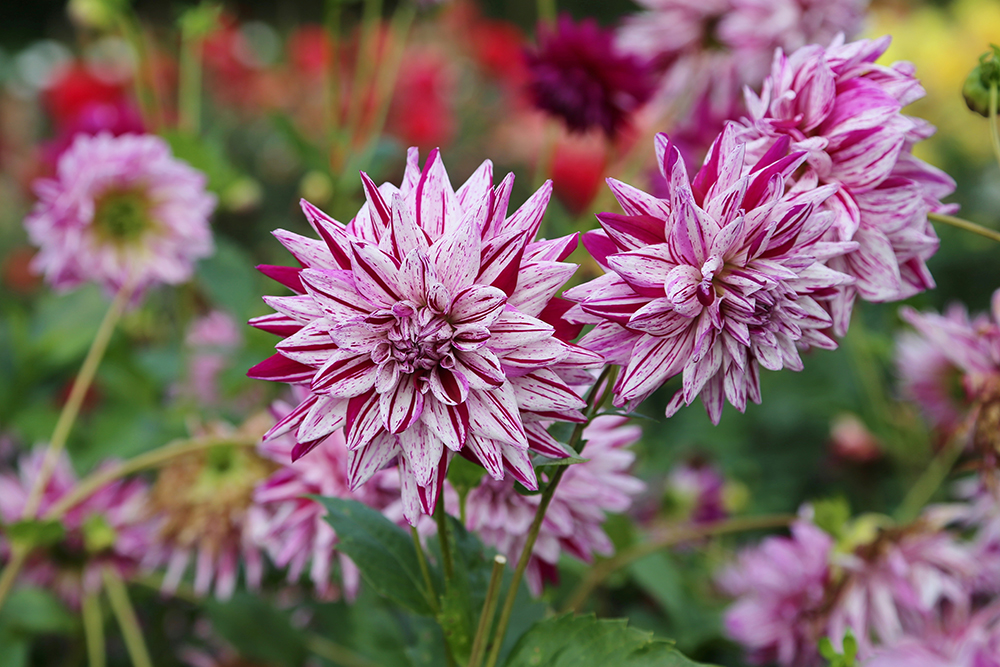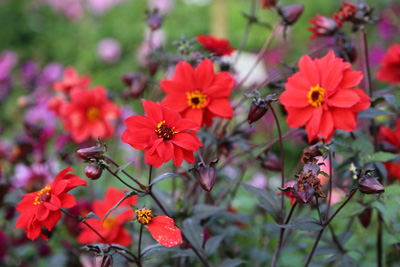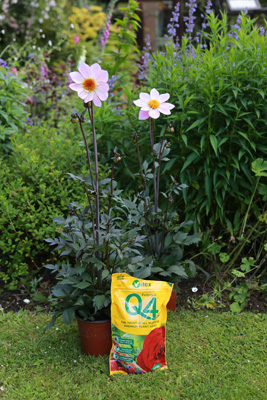Dahlias for late summer colour

Dahlias for late summer colour
Dahlias are such wonderful plants for late summer colour; they are versatile too. Some varieties are ideal for pots, others perfect for the border. The range of colours and flower forms is vast and they produce wonderful flowers to cut for the house. They are even great value if you use them to add colour just for a season, however most make excellent long-term perennials that will light up the garden year after year.
Growing dahlias
Nearly all dahlias produce tubers: roots that store food and water reserves beneath the soil. These enable the plants to survive when they lay dormant beneath the ground over winter. Traditionally dormant tubers are planted in early spring, sometimes in their planting positions, but more usually in pots indoors for planting out after danger of frost has passed. Dahlias are not frost hardy and are knocked back to ground level by the first frost in autumn.
Today dahlias are often left in the ground from year to year, rather than lifting and storing them over winter. Most survive quite happily, especially in borders where they are sheltered by walls and fences of surrounding plants. They are usually late to emerge the following year and are often only a few centimetres high by early summer. This is the time to mulch with good garden compost and make sure they are free from competition from weeds and surrounding plants. This is also a time to protect them from slugs: the new shoots can be vulnerable. Vitax Slug Gone is ideal, just sprinkle a circle of pellets around each plant where they will swell to make an impenetrable barrier. Vitax Slug Gone is made from wool waste. It is organic and gradually breaks down in the soil to feed the plants.
Growing dahlias need plenty of water and plenty of nutrients. Give each plant a generous handful or two of Vitax Q4 pelleted fertiliser. Sprinkle it around the emerging shoots and lightly fork it into the soil; This provides all the right nutrients, including plenty of potash for hardened growth and abundant flowers.

Support
Dahlias produce strong, upright stems, however all but the shortest most compact varieties benefit from some support. This can be achieved with canes or hazel twigs, but better still put a strong gro-thru support in position as the shoots emerge. This must have large holes for the stems to grow through and it really just needs to support the base of the stems where they are most vulnerable.
Planting new dahlias
Many dahlias are sold as pot-grown plants starting to flower from early summer onwards. These are a great way to add instant colour and fill gaps in the border. They may have been raised from tiny plug plants, so will not have developed underground tubers when you plant them. However they have plenty of time for these storage organs to grow beneath the soil in preparation for the following winter. Many will survive quite happily to bloom again the following year.
As you are planting when the weather is warmer they will need generous watering before and after you plant them. Add a couple of handfuls of Vitax Q4 fertiliser to the soil when you plant to get them off to the best possible start.

Dead-heading
Dahlia petals tend to fall away when the flower fades and initially it can be quite tricky to recognise the difference between a flower bud and the remains of a faded bloom. Usually the former is rounder and the latter reveals the remains of the stamens. Once you can tell the difference regular dead-heading will help to keep your dahlias blooming for longer, usually well into autumn.
Andy McIndoe
Your login details have been used by another user or machine. Login details can only be used once at any one time so you have therefore automatically been logged out. Please contact your sites administrator if you believe this other user or machine has unauthorised access.












